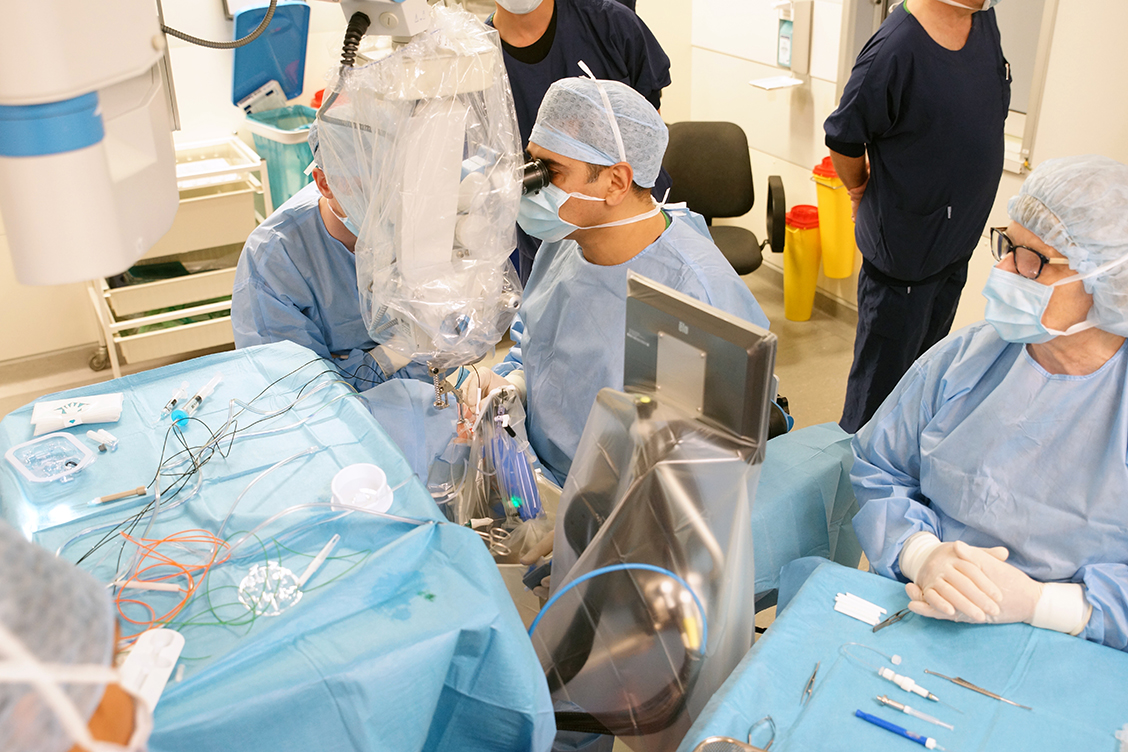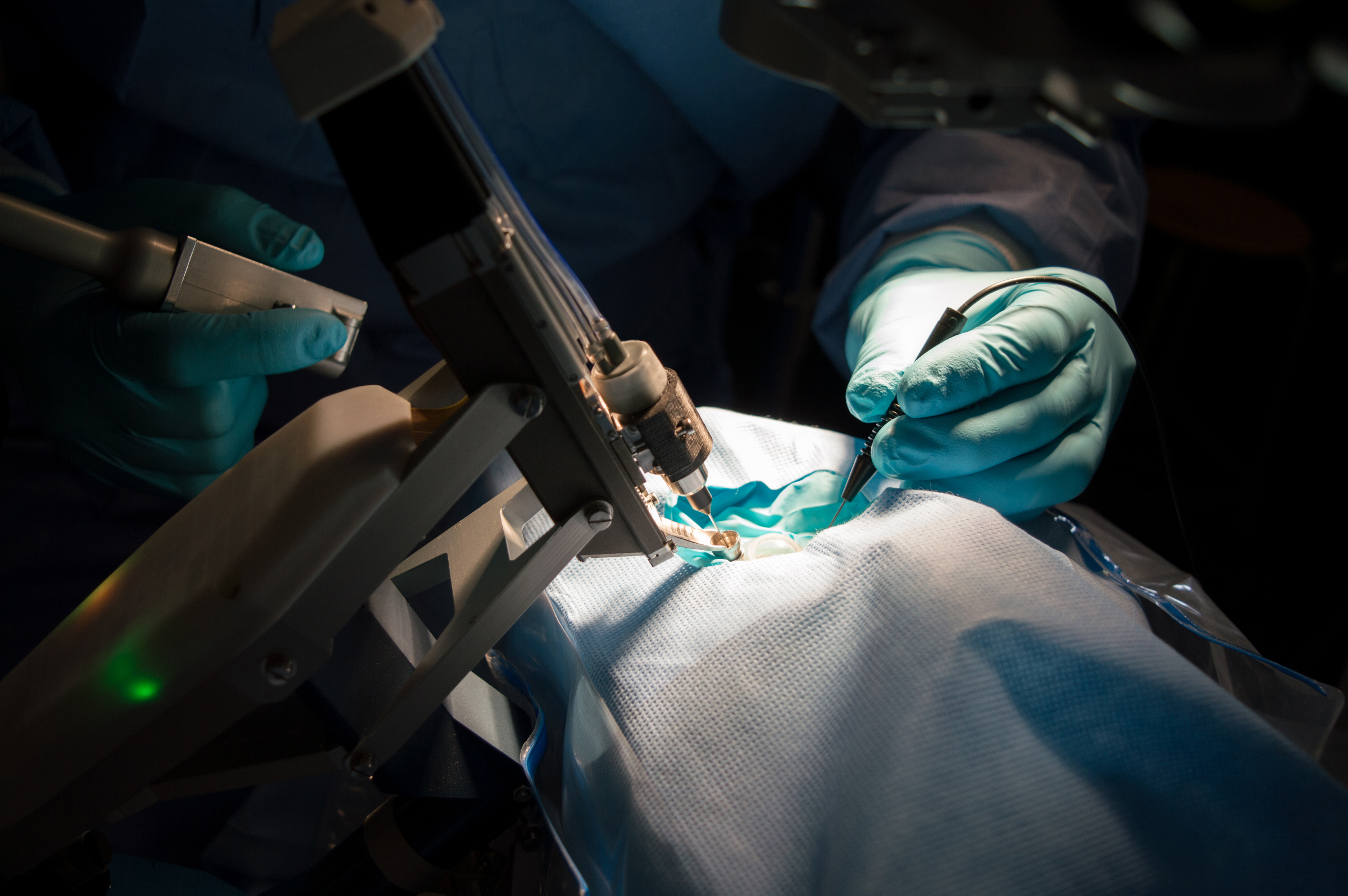World’s first clinical trial of a robot in routine vitreoretinal eye surgery begins: Preceyes’ robotic assistant used for ERM peels at Rotterdam Eye Hospital
Eindhoven, 15 May 2019
Precision and accuracy are precisely what’s needed when eye surgeons perform a procedure called an epiretinal membrane (ERM) peel. And a Dutch robotics company, Preceyes (Eindhoven, the Netherlands) in combination with the Rotterdam Eye Hospital (REH; Rotterdam, the Netherlands) has started a clinical trial of its PRECEYES Surgical System (PSS) robotic assistant to see if it can do just that.
As many as 1 in 10 people aged 60 years or older have their vision significantly distorted by an epiretinal membrane – a micron-thin sheet that grows over the most light-sensitive part of the retina called the macula and can greatly reduce central vision. Removing the ERM (and restoring better vision) requires a surgeon to grab and gently peel away the membrane, in a procedure called an ERM peel. Only highly trained specialist eye surgeons can perform these peels, and it’s a process that has them working at the absolute limits of their visual and motor skills.
The question Preceyes and REH want to answer is: can a robotic assistant automate parts of the procedure, and perform an ERM peel at least as safely (if not better) than a human surgeon can? Can the PSS robot perform the peel more precisely and reproducibly than humans?
To answer this, as part of a multi-year collaboration between REH and Preceyes, they are performing a randomized, prospective, open-label surgical intervention study to compare robotic assistance to standard manual surgery. Both arms of the study start in the same way: manually performed vitrectomy and peripheral laser. During the rest of the procedure, the following steps were assisted by the PSS:
- Light pipe positioning to illuminate the retina
- Dye staining and removal
- ERM flap initiation with a pick
- ERM grasping and peeling with forceps
- Fluid and gas exchange.

What both Preceyes and REH want to know from the trial is if the PSS robotic assistant can make an impact on what is very routine and commonly performed retinal surgery, in terms of the duration of surgery, the number of attempts required to initiate and peel the membrane, as well as anatomical and visual function outcomes at 1 and 3 months after surgery.
When it comes to the use of the robot during surgery, Preceyes’ Chief Medical Officer, Prof. Marc de Smet, MD, noted that surgeons viewed “the use of the forceps fully operated by the robot with multiple grabs to peel a membrane as the most impressive part of the operation, closely followed by the fact that interchangeable instrument tips can be placed on the robot to carry out different tasks”, before adding “The surgeon can, in essence, choose the instrument he or she needs and use it with the robot, and use it with high precision.”
The PSS should also have some additional benefits for the surgeon: easing the strain, and improving the precision and reproducibility of numerous surgical tasks in the eye. Surgeons should no longer need to work at their absolute visual and motor limits to perform this routine surgical procedure. The investigators hope that the study will provide valuable insight and support for the future use of robotic assistance in everyday vitreoretinal surgery – with the objective of reducing the burden on surgeons and improving the reproducibility of outcomes.

Koorosh Faridpooya MD, senior retinal surgeon and lead investigator at the REH, said: “This is an important step in ophthalmology. For the first time we were able to perform a complete peeling of the ERM using the robot. The eye is a complex organ: we work within a very small area during eye surgery, meaning that the eye surgeon must be very, very precise when operating. The surgical robot helps the surgeon by increasing his accuracy. We therefore expect that we can reduce the number of complications and improve the outcomes of our patients.”
Further information
Preceyes, Gerrit Naus, CEO Preceyes, , +31 (0)40 247 4789
Rotterdam Eye Hospital, Robert Spiering, , +31 (0)6 23753275
About Preceyes
Preceyes B.V. is a medical robotics company focused on ocular surgery. The company develops, builds and commercializes innovative robotic solutions to assist eye surgeons in performing the most demanding of surgical tasks. The company’s first target is vitreoretinal surgery. The robot supports the surgeon in improving existing surgery and enables the development of new, high-precision treatments. Preceyes is a spinout of the Eindhoven University of Technology and is located at the TU/e Science Park in Eindhoven, the Netherlands. Preceyes leverages the mechatronics capability of the Dutch Brainport region. www.preceyes.nl
About the Rotterdam Eye Hospital
The Rotterdam Eye Hospital serves as a top institute for ophthalmic care. Every year, more than 12,500 surgeries are performed in the hospital and 139,000 outpatient clinic visits take place. The Rotterdam Eye Hospital is founder and member of the World Association of Eye Hospitals, a worldwide association of specialist ophthalmic centres. www.oogziekenhuis.nl
Funding
The Coolsingel Foundation (www.stichtingcoolsingel.nl) and the Netherlands Organisation for Scientific Research (www.nwo.nl/en) have financially contributed to enable the robotic study.
